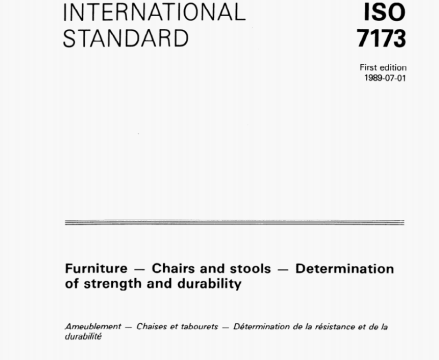ISO 7173 pdf download – Furniture – Chairs and stools – Determination of strength and durability.
7.6 Scat fatigue test
Apply the force of 950 N by means of the seat loading pad (6 3) with the centre of the loading pad positioned at the seat loading position determined as in the Onncx. Apply the force for the appropoate number of times specified in the table at a rate not exceeding 40 cycles per minute.
Mcasurc thc lowost position of thc pad during the first and the last cycle of the test Record the difference of the two values obtained as the deflection of the seat during the test.
If required, repeat the test on footrails or footrosts at the appropriate test leveL
7.6 Back fatigue test
Position the centre of the back loading pad (6,5) either at the back loading position determined as n the annex, or at 1UU mm below the top of tête back, wtiichevei is the lowet Prevent the chair from moving rearwards by placing stops behind the roar feet or castors. Conduct the test by the repeated application of a lorce of 3O N. ui if the chair oveibalances, of such lesser force as to prevent roarwards ovcrbaloncing. Carry out the test at a rate on, esreading 40 cycles per minute for the appropriate number of applications specified in the table, During each cycle apply a force of 050 N to the seat (see figure 6).
When this test is applied to a chair fifled with a spring rocking action base that has a tension adjustment, adjust the tension to the midc of its range of adjustment.
When this test is applied tea stool without a backrest, or with a vely low back, apply tête backward force horieuntally to the front edge of the scat. Test stoot with four logs on which the seat surface is no? symmetrical both with the seat mafrw din’ienslons sideways, and with the major dimensions fore and aft for half the number of applications of the force in each of the two directions Test stools with three legs along two of the principle axes of the three feet.
NOTE – Because the number of cycles and the seat load are com’nu.i to both the seat and hack fatigue tests it is normally convenient to perform these two tests Iufett1e. as a colTibined seat and bec.k fatigue
test In this case the seat lotd chnnld he apØlI’d first and then maintamed while the (sick load is applied
‘7.7 Leg forward static load test
Restrain the front feet of the chair or stool horn movement whst applying a horizontal force centrally to the roar of the chair at seat level in a forward direction, by means of the local loading pad (8.61. For stools with only three legs, one foot on the fore and aft centre line and one other foot should be restrained. The maximum force shall be the appropriate force specified in the table.
Apply the appropriate seat load specified in the table at the sect loading position specified by the chair loading position template (see figure 201. If the chair or stool tends to overbalance. reduce the load to a magnitude that just prevents forward overbalancing, and record the actual force used. ISee figure 7 a).)
Apply the forward leg load 10 limos, and during cach opplica tion, maintain the load for at least 10 s
78 Leg sideways static load test
Carry out this test in the same mannei as the leg forward static loading test except restrain a pair of front and rear feet from movement whilst applying a horiiontal force centrally to the side of the article seat level, in e sideways towards the restraining foot. Apply tho appropriate vertical seat load specified in the table at a aitahle pncitinn across the seat hut not more than 150 mm from the unloaded edge of the seat. Apply the horizontal foce 10 times, and during each opplicotion maintain the load for at least lOs. The maximum force shall be that specified In the table. (See figure 7 b).
If the artide tends to overbalance with the vertical seat load in Its furthermost position from the unloaded edge. reduce the horizontal seat loading force to a magnitude that just prevents sideways overbalancing, and record the actual force used.
ISO 7173 pdf download – Furniture – Chairs and stools – Determination of strength and durability
